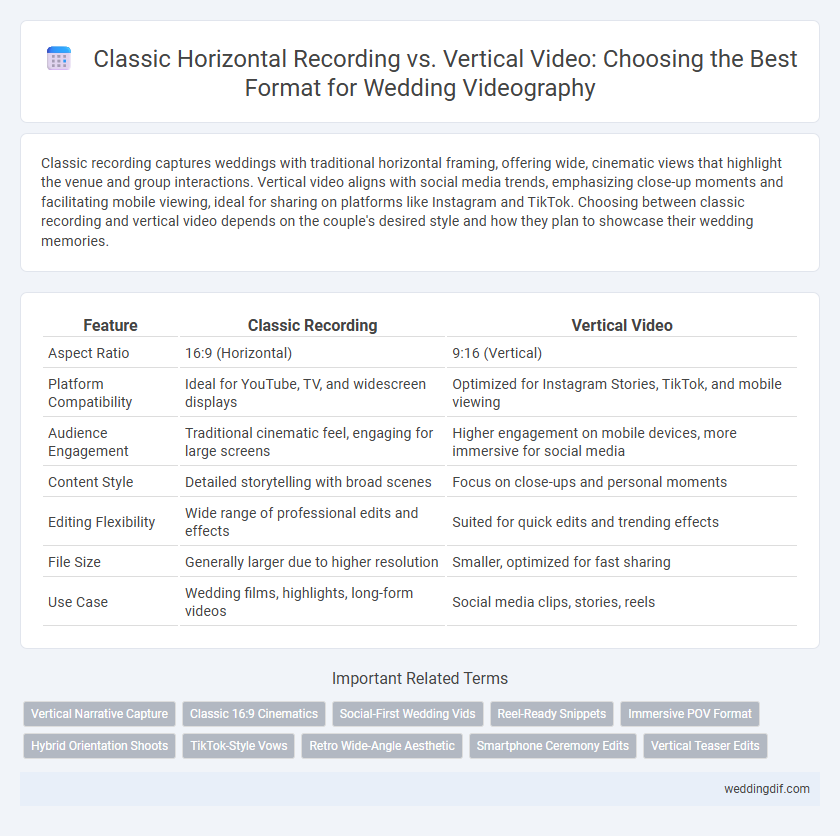Classic recording captures weddings with traditional horizontal framing, offering wide, cinematic views that highlight the venue and group interactions. Vertical video aligns with social media trends, emphasizing close-up moments and facilitating mobile viewing, ideal for sharing on platforms like Instagram and TikTok. Choosing between classic recording and vertical video depends on the couple's desired style and how they plan to showcase their wedding memories.
Table of Comparison
| Feature | Classic Recording | Vertical Video |
|---|---|---|
| Aspect Ratio | 16:9 (Horizontal) | 9:16 (Vertical) |
| Platform Compatibility | Ideal for YouTube, TV, and widescreen displays | Optimized for Instagram Stories, TikTok, and mobile viewing |
| Audience Engagement | Traditional cinematic feel, engaging for large screens | Higher engagement on mobile devices, more immersive for social media |
| Content Style | Detailed storytelling with broad scenes | Focus on close-ups and personal moments |
| Editing Flexibility | Wide range of professional edits and effects | Suited for quick edits and trending effects |
| File Size | Generally larger due to higher resolution | Smaller, optimized for fast sharing |
| Use Case | Wedding films, highlights, long-form videos | Social media clips, stories, reels |
Introduction to Wedding Videography Trends
Classic recording in wedding videography emphasizes traditional landscape framing that captures wide, cinematic shots highlighting venue details and group interactions. Vertical video, optimized for social media platforms like Instagram and TikTok, focuses on close-up moments and dynamic storytelling through smartphone-friendly formats. Emerging trends show couples prefer a mix of both styles to create versatile wedding films that resonate across diverse viewing platforms.
What is Classic Wedding Video Recording?
Classic wedding video recording captures the ceremony and reception using traditional horizontal framing, emphasizing a cinematic and timeless aesthetic. This method prioritizes widescreen compositions, depth of field, and professional camera movements to document key moments with clarity and elegance. It remains the preferred choice for capturing wedding memories intended for full-screen playback on televisions and computers.
The Rise of Vertical Video in Weddings
Vertical video has surged in popularity for wedding videography, driven by the dominance of smartphones and social media platforms like Instagram and TikTok that favor portrait orientation. Unlike classic horizontal recording, vertical video captures intimate close-ups and candid moments more naturally, aligning with modern viewing habits. Wedding videographers increasingly adopt vertical formats to create engaging, shareable content that resonates with younger audiences and enhances the storytelling experience.
Visual Aesthetics: Horizontal vs Vertical Framing
Horizontal framing in classic wedding videography captures expansive scenes, ensuring a cinematic and immersive visual experience with balanced composition and natural eye movement. Vertical video framing suits modern social media sharing, focusing on intimate close-ups and dynamic moments, but may limit contextual background and reduce visual depth. Choosing between classic horizontal and vertical video depends on the desired emotional impact and platform compatibility for wedding memories.
Storytelling Impact: Classic vs Vertical Approaches
Classic recording captures weddings with cinematic widescreen framing, offering expansive storytelling that emphasizes setting and emotional nuances. Vertical video aligns with social media trends, driving immediacy and intimacy through close-up shots but can sacrifice broader context and traditional narrative depth. Choosing between classic and vertical formats influences how wedding stories resonate, balancing immersive atmosphere with modern, bite-sized engagement.
Social Media Sharing: Which Format Wins?
Vertical video dominates social media sharing for weddings, aligning perfectly with mobile device screens and platforms like Instagram Stories, TikTok, and Snapchat. Classic recording, with its traditional 16:9 aspect ratio, suits cinematic storytelling and wide-angle shots but often requires cropping or reformatting for social feeds. For maximum engagement and seamless sharing, vertical video provides a user-friendly experience that matches current social media consumption habits.
Guest Experience: How Video Style Affects Memories
Classic recording captures weddings in traditional 16:9 format, offering a cinematic feel that highlights wide scenic views and group moments, enhancing the emotional depth of memories. Vertical video, optimized for smartphones, delivers an intimate and immediate perspective, engaging guests who prefer quick, shareable clips on social media platforms. The choice between classic and vertical styles significantly influences how guests relive and share wedding memories, balancing cinematic storytelling with modern digital consumption.
Technical Considerations: Equipment and Editing
Classic recording for weddings relies on traditional 16:9 aspect ratio cameras, utilizing DSLRs or mirrorless cameras with wide lenses to capture expansive scenes and detailed close-ups. Vertical video requires smartphones or cameras with vertical framing capabilities, often paired with gimbals or stabilizers for smooth handheld shots, and demands editing software that supports vertical timelines to maintain resolution and aspect ratio integrity. Editing vertical footage involves cropping and repositioning shots differently than classic videos, ensuring key moments remain centered, while classic editing workflows prioritize horizontal framing and multi-camera angles.
Cost and Package Differences
Classic recording for weddings typically involves traditional 16:9 aspect ratio footage, using professional cameras and multi-angle setups, often resulting in higher production costs and premium packages with extensive editing and extras like highlight reels. Vertical video, optimized for mobile viewing on platforms like Instagram and TikTok, tends to use simpler equipment or smartphone filming, which significantly lowers production expenses and allows for more affordable, streamlined packages focused on quick edits and social media-ready content. Couples choosing between the two should consider budget constraints and the desired final format, as classic recordings offer cinematic quality, while vertical videos cater to modern digital sharing trends.
Choosing the Right Style for Your Wedding
Classic recording offers timeless, cinematic footage with balanced framing and wide shots that capture the full ambiance of weddings, ideal for traditional viewing on large screens. Vertical video caters to modern social media platforms like Instagram and TikTok, emphasizing close-up moments and real-time interactions, perfect for quick sharing and mobile viewing. Evaluating your audience and how you plan to showcase your wedding video ensures choosing a style that complements your memories and preferred viewing experience.
Classic Recording vs Vertical Video for weddings Infographic

 weddingdif.com
weddingdif.com